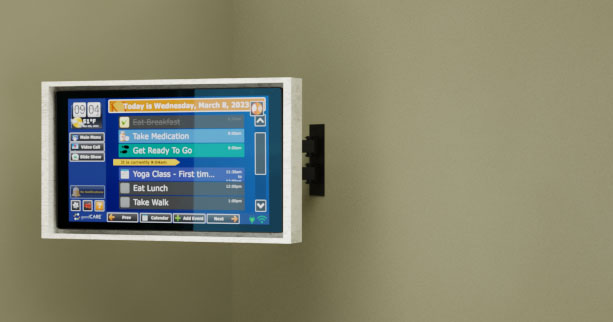‘It’s a gift from God’: Cybermation tele-health venture makes it easier to monitor activity, medications
Written by Kevin Allenspach
12:40 AM, Dec. 11, 2011
St. Cloud Times – www.sctimes.com
See a video of GrandCare Client, Ed Thelen, discussing why the GrandCare System works for him and how it has been a lifesaver and lifted his spirits! http://link.brightcove.com/services/player/bcpid950566939001?bckey=AQ~~,AAAACbynFGE~,sf-WXU5Jxxvzf0yBwv5ezSaUvcZFydJt&bctid=1320587839001
COLD SPRING — After complications from shoulder surgery made it difficult for 69-year-old Ed Thelen to sleep in a bed at night, he’s taken to dozing in a giant easy chair in the living room of his third-floor home at John Paul Apartments. That discomfort isn’t his only concern. He also has a pacemaker, battles diabetes, struggles with Parkinson’s disease and is in a constant fight against obesity and depression. His biggest worry, though, is whether he’ll be able to keep a new device that has revolutionized his life.
As Thelen relates how he came to this place after 45 years of moving around the region as an insurance underwriter, something that looks like a flat-screen TV chirps next to his chair. He reaches over, touches a prompt, and within seconds is talking with his daughter via Skype.
After their conversation, he shows a visitor how the screen also notifies him if he has letters, pictures or video sent from one of his six grandchildren. He calls up his blood-pressure readings from the past month, which he can provide directly to his doctor, and demonstrates how it prompts him to take his pills — morning, noon and night — from a dispenser in the kitchen.

Ed Thelen, 69, of Cold Spring is able to live in his apartment with the help of an integrated monitoring system marketed locally by Cybermation. With the system, Thelen and others can monitor his health and activities and communicate with him through a touch screen he has in his living room. Jason Wachter, jwachter@stcloudtimes.com
“It’s phenomenal,” Thelen said with a hint of emotion behind his eyes. “If I forget to take my medication, it sends a signal and the phone rings. A voice says (with a nasal twang) ‘Mr. Thelen, you haven’t taken your medication.’ With all the things it does, to me it’s a gift from God.”
It is a GrandCare System, a product of a company in West Bend, Wis., that is being marketed locally for the first time by Cybermation, a Waite Park-based business that for 15 years was primarily known for home entertainment and security systems. Thelen has been working with it for about three weeks.
“We’ve mostly been about big boys toys,” Cybermation President Tom Ardolf said. “Commercial and residential people come to us and spend tens of thousands of dollars on their home theater, or they bring us a basket of remotes and ask us to create one that will run everything in their house. But late last year I got a call from a distributor that had known us for 10 years. They’d started a tele-health venture. I just wanted to ask the guy if we could go fishing. He said, ‘You really ought to look into this.’ ’’
Soon after he did, Ardolf decided to launch CyberHealth, a new division of Cybermation. His company is one of more than 300 authorized installers for the GrandCare System in the U.S. and Canada. Four are in Minnesota, with the other three in the Twin Cities metro area.
He said he’s working with an unnamed rural health care provider to distribute the GrandCare System on a wider scale. And, with baby boomers entering retirement and becoming elderly, remote monitoring is expected to be a $9.3 billion industry by 2014.
“My mom passed in 2007, and I often think of how my life, my mom’s life and that of my sisters would’ve been different if we’d had something like this,” Ardolf said.
Family connections
Gladys Ardolf lived in Maple Lake and was 78 when she died of complications from dystonia, a movement disorder that causes muscles to contract and spasm involuntarily. For the last six to eight years of her life, two of Tom Ardolf’s three sisters living in the area made daily — sometimes twice-daily — visits to make sure she was all right.
“The average caregiver puts in 24 hours a week — that’s a significant part-time job,” said Ardolf, 50. “People are willing to do it, especially when it’s their mom or their dad. But around year one or two, there’s invariably some resentment about ‘Why doesn’t this sibling who lives far away do something to help?’ If we’d had one of these systems, I could’ve played a role in her care — even though I’m 40 miles away.”
While the screen is in the user’s home, like the one next to Thelen’s easy chair, it provides a window for family members, caregivers and physicians to monitor the user’s health and activities.
“Just by placing sensors around my mom’s home, I could’ve had a call or text sent to my phone if she didn’t get up between 6 and 9 a.m.,” Ardolf said. “I would’ve known if she was restless in bed, went to the bathroom or didn’t take a shower. We could’ve put a magnet on the microwave that would’ve told us if she’d had coffee in the morning. It’s little things like that which can give you peace of mind — or alert you to trouble if they don’t happen.”




